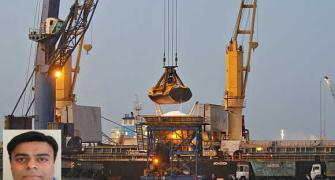 China's economic growth is set to decline to 7.7 per cent this year, as against 9.3 per cent last year, due to global slowdown, the World Bank said on Monday.
China's economic growth is set to decline to 7.7 per cent this year, as against 9.3 per cent last year, due to global slowdown, the World Bank said on Monday.
Weak exports and lower investment growth will cut down China's GDP growth, it said.
Besides, economic growth in the East Asia and Pacific region may slow down from 8.2 per cent in 2011 to 7.2 per cent this year, before recovering to 7.6 per cent in 2013, it said in the East Asia and Pacific Economic Data Monitor.
Growth in developed countries will remain modest, with recovery in the region to be driven mainly by strong domestic demand in developing countries, a press release outlining the Bank's assessment report said.
On China, it said that the growth is expected to rebound to 8.1 per cent as the impact of stimulus measures kicks in, supported further by an up tick in global trade.
The country's growth in the first half of this year cooled to 7.6 per cent, its lowest in more than three years.
In August, the manufacturing purchasing managers' index dipped below 50 points for the first time in nine months, indicating contraction. Exports remained weak, growing only 2.7 per cent in August from a year earlier.
China has announced about $157 billion worth of stimulus package mainly in the infrastructure to spur growth.
The Bank said investment growth in China has slowed in particular, driven by last year's measures to rein in investments in real estate.
However, relaxation in monetary policy earlier this year and local and central government stimulus measures could again reverse this trend in months to come, it said.
"The East Asia and Pacific region's share in the global economy has tripled in the last two decades, from 6 per cent to almost 18 per cent today, which underscores the critical importance of this region's
"Even under difficult global circumstances, poverty in the region will continue to decline, with the share of people living on $2 a day expected to reach 24.5 per cent by the end of 2013, down from 28.8 per cent in 2010," said Pamela Cox, World Bank East Asia and Pacific Regional vice president.
"Weaker demand for East Asia's exports is slowing the regional economy, but compared to other parts of the world, it's still growing strongly, and thriving domestic demand will enable the region's economy to bounce back to 7.6 per cent next year," the release said.
The World Bank report noted that tensions in the Euro Zone have eased following the European Central Bank's announcement to defend the common currency in July and the launch of its bond-buying program that significantly calmed the markets.
Also, the recent announcements by the US Federal Reserve regarding a new round of quantitative easing to help stimulate the American economy has helped revive global equity markets.
However, the report said considerable downside risks remain, adding that should conditions in Europe deteriorate sharply, the chances are high that developing economies might be affected.
A crisis in the euro zone will adversely affect the economies in the East Asia and Pacific mainly through trade and links to the financial sector.
The report considers food price increases less of a risk for East Asia at this stage, as rice markets remain well supplied.
Policy makers in the East Asia and Pacific Region will have to continue managing growth and reducing poverty in an environment that will remain volatile, it said.
Countries that have experienced rapid expansion of credit need to be cautious, while exporters of commodities should continue to take measures and build institutions that help manage volatile commodity revenues, it added.









